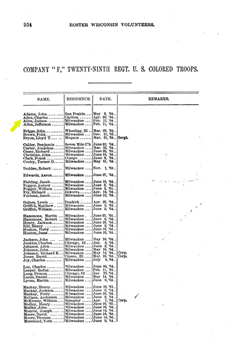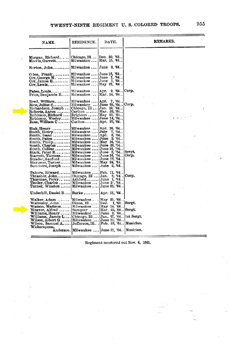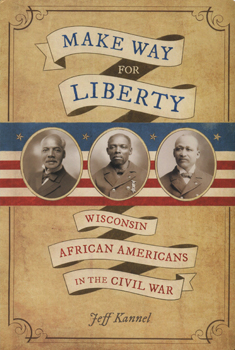Local History Topics
Cheyenne Valley
Museum Notes
by Kristen Parrott, curator
for the week of 2/11/2015
Wisconsin researcher Jeff Kannel has just sent us a copy of his newly-published booklet, Cheyenne Valley Civil War Veterans of Company F, 29th Regiment, United States Colored Troops. Cheyenne Valley was a mixed-race community located in Town of Forest, Vernon County.
The booklet focuses on four African-American Civil War soldiers from Cheyenne Valley – Charles Allen, Aaron Roberts, William Stewart, and Alfred Weaver – plus Abram Thornton from Sauk County, whose life was interwoven with Cheyenne Valley residents although he never lived there himself.

Roster of the Company F, 29th Regiment, USCT listing Charles Allen.
African Americans were technically forbidden from serving as soldiers until the Emancipation Proclamation of January 1, 1863 (although some “passed” as white and enlisted before that date). After the proclamation, African Americans were officially allowed to serve only in the segregated regiments of the United States Colored Troops (U.S.C.T.).
Wisconsin did not raise a regiment of Colored Troops because the state’s African-American population was too small. Illinois did raise a regiment – the 29th Regiment, U.S.C.T. When it became apparent that Wisconsin men were going south to join that regiment, Wisconsin created its own company, Company F, within the 29th.
This company is the focus of Jeff Kannel’s new booklet. The five men he writes about all served in Company F. Stop by the museum to look at this new resource. Copies of all or part of the booklet can be made for interested researchers.

by Kristen Parrott, curator
for the week of February 9 – 15, 2020
Voting is on everyone’s mind these days, with several upcoming elections. It was on people’s minds 150 years ago, too, in February of 1870, when the 15th Amendment to the U.S. Constitution was ratified. This amendment declares that “The right of citizens of the United States to vote shall not be denied or abridged by the United States, or by any State, on account of race, color, or previous condition of servitude.”
The purpose of the amendment was to give the vote to African-American men. Women did not get the vote until 1920. And in reality, many African Americans, especially those living in the South, were denied the vote until the passage of the Voting Rights Act of 1965.
Frederick Douglass, who escaped slavery himself and then worked to abolish it, urged passage of the 15th Amendment on the grounds that all soldiers who fought in the Civil War deserved the right to vote. This included the African-American soldiers who had served in the United States Colored Troops (U.S.C.T.) during the war.
Several local people served in the U.S.C.T. Four men from Vernon County’s Cheyenne Valley area in the Town of Forest served in Company F of the 29th Regiment of the U.S.C.T.: Charles Allen, Aaron Roberts, William Stewart, and Alfred Weaver. Wisconsin historian Jeff Kannel has researched these men and written a short booklet about them, available from our museum’s bookstore. He is also working on a full-length book about Wisconsin’s African-American Civil War soldiers. [Note: This book has now been published. Its title is Make Way for Liberty: Wisconsin African Americans in the Civil War.]
In addition to these four men, others from Vernon County were also affected by the passage of the 15th Amendment. Ed Harris was born into slavery and came to Vernon County shortly after the Civil War. He farmed in the Town of Union. The 1884 History of Vernon County notes that he prepared to move north to Canada shortly before the presidential election of 1868, fearing that if Seymour and Blair were elected, slavery would be reinstated.
Instead, Ulysses S. Grant was elected President, and Schuyler Colfax became Vice President. One year later, with the President’s support, Congress approved the 15th Amendment, and by 1870, three-fourths of the states had ratified it and the amendment was entered into the U.S. Constitution.
President Grant then wrote to Congress, “A measure which makes at once 4,000,000 people voters who were heretofore declared by the highest tribunal in the land not citizens of the United States, nor eligible to become so…is indeed a measure of grander importance than any other one act of the kind from the foundation of our free Government to the present day.” These words from a man who had himself once owned an enslaved person.
So, Ed Harris did not move to Canada and continued to live in Vernon County. He remained a free person, and lived to see the day when he also could vote.

 MENU
MENU
